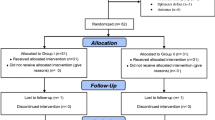Abstract
We herein present a study conducted on 14 patients presenting cancer of the lower rectum or of the anal canal (10 adenocarcinomas and 4 squamous-cell carcinomas) and submitted to the Miles abdominal perineal resection in which a new perineal sphincter was constructed. PURPOSE: The aim of this study was to evaluate the efficacy of this new perineal sphincter constructed by transposing the gracilis muscles around an orthotopic colostomy in the attempt to avoid a permanent abdominal colostomy. METHODS: In all cases both gracilis muscles were employed. The right one was placed along the posterior wall of the pelvis and fixed to the controlateral ischiatic tuberosity, creating a sling comparable to the levator ani muscles. The left gracilis was passed around the colon and attached to the ipsilateral or controlateral tuberosity according to its length, reconstructing a muscular ring. The entire procedure was performed in one step in nine cases and in more steps in the remaining five. RESULTS: Of the 14 operated patients, 2 died of vascular disease and 1 developed necrosis of the colonic stump which required reconversion to an abdominal colostomy. Of the remaining 11 patients available for long-term evaluations, 8 showed adequate stool control. The remaining three manifested an incomplete level of continence. During the three-year follow-up period, all patients were evaluated by clinical examination, defecography, endoluminal ultrasonography, nuclear magnetic resonance, CT scan, and endoluminal manometry. CONCLUSION: This neosphincter realizes an elastic stenosis responsible for an efficient level of continence. Best results are observed in the young and educated patients submitted to surgery in two steps. Contraindications to this surgery seem to be advanced cancer, old age, and obesity.
Similar content being viewed by others
References
Miles EW. The radical abdomino-perineal operation for cancer of the rectum and of the pelvic colon. BMJ 1910;2:1941.
Stone HB, McLanahan S. Results with the fascia plastic operation for anal incontinence. Ann Surg 1941;114:73–7.
Sistrunk W. Contribution to plastic surgery. An operation laceration of anal sphincter. Ann Surg 1927;85:185–93.
Chittenden AS. Reconstruction of anal sphincter by muscle slips from the glutei. Ann Surg 1930;92:152–4.
Bistrom O. Plastischer ersatz m. spincter ani. Acta Chir Scand 1944;90:431.
Devesa JM, Vicente E, Enriquez JM,et al. Total fecal incontinence—a new method of gluteus maximus transposition: preliminary results and report of previous experience with similar procedure. Dis Colon Rectum 1992;35:339–49.
Pearl RK, Prasad ML, Nelson RL, Orsay CP, Abcarian H. Bilateral gluteus maximus transposition for anal incontinence. Dis Colon Rectum 1991;34:478–81.
Schmidt E. The continent colostomy. World J Surg 1982;6:805–9.
Christiansen J, Sparso B. Treatment of anal incontinence by an implantable prosthetic anal sphincter. Ann Surg 1992;215:383–6.
Pickrell KL, Broadbent TR, Masters FW, Metzger JT. Construction of a rectal sphincter and restoration of anal continence by transplanting the gracilis muscle: a report of four cases in children. Ann Surg 1952;135:853–62.
Simonsen SO, Stolf NA, Aun F, Raisa A, Habr-Gama A. Rectal sphincter reconstruction in perineal colostomies after abdomino-perineal resection for cancer. Br J Surg 1976;63:389–91.
Mercati U, Trancanelli V, Castagnoli GP,et al. Ricostruzione sfinterica dopo amputazione del retto con l'impiego dei muscoli gracili. Chirurgia 1991;4(Suppl):74–81.
Williams NS, Hallan RI, Koeze TH, Watkins ES. Restoration of gastrointestinal continuity and continence after abdominoperineal excision of the rectum using an electrically stimulated neoanal sphincter. Dis Colon Rectum 1990;33:561–5.
Corman ML. Follow-up evaluation of gracilis muscle transposition for fecal incontinence. Dis Colon Rectum 1980;23:552–5.
Leguit P Jr, Nan Baal JG, Brummelkamp WH. Gracilis muscle transposition in the treatment of fecal incontinence: long-term follow-up and evaluation of anal pressure recordings. Dis Colon Rectum 1985;28:1–4.
Christiansen J, Sorensen M, Rasmussen O. Gracilis muscle transposition for faecal incontinence. Br J Surg 1990;77:1039–40.
Williams NS, Pilot MA, Hallan RI, Watkins ES, Koeze HT. Construction of a neoanal sphincter by transposition of the gracilis muscle and prolonged neuromuscular stimulation for the treatment of faecal incontinence. Ann R Coll Surg Engl 1990;72:108–13.
Toupet A. Operation de Pickrell modifiee. J Chir 1981;1:57–62.
Williams NS, Patel J, George BD, Hallan RT, Watkins ES. Development of an electrically stimulated neoanal sphincter. Lancet 1991;338:1166–9.
Author information
Authors and Affiliations
About this article
Cite this article
Santoro, E., Tirelli, C., Scutari, F. et al. Continent perineal colostomy by transposition of gracilis muscles. Dis Colon Rectum 37 (Suppl 2), S73–S80 (1994). https://doi.org/10.1007/BF02048436
Issue Date:
DOI: https://doi.org/10.1007/BF02048436




